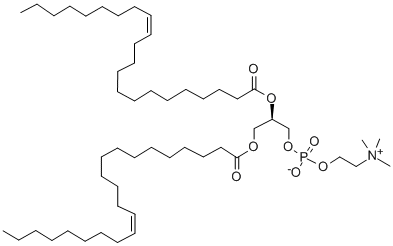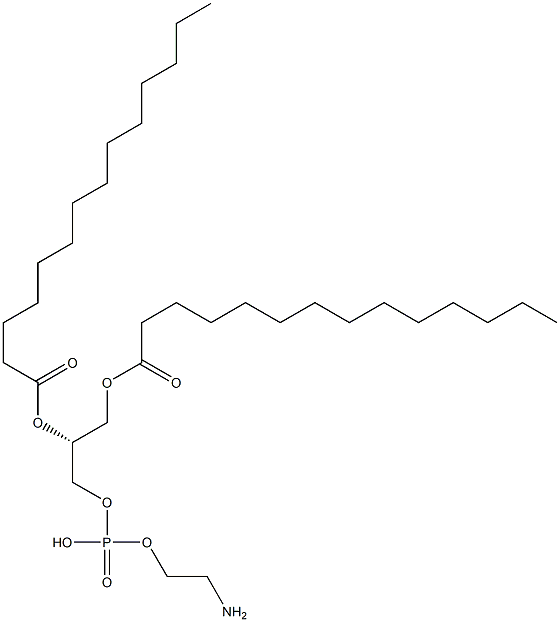1,2-DI13-CIS-DOCOSENOYL-SN-GLYCERO-3-PHOSPHOCHOLINE
Synonym(s):PC;DEPC;PC(22:1(13E)/22:1(13E));(7R,22Z)-4-Hydroxy-N,N,N-trimethyl-10-oxo-7-[[(13Z)-1-oxo-13-docosen-1-yl]oxy]-3,5,9-trioxa-4-phosphahentriacont-22-en-1-aminium 4-oxide, inner salt;1,2-di-(13Z-docosenoyl)-sn-glycero-3-phosphocholine; PC(22:1(13Z)/22:1(13Z)); DEPC
- CAS NO.:51779-95-4
- Empirical Formula: C52H100NO8P
- Molecular Weight: 898.33
- MDL number: MFCD00674315
- SAFETY DATA SHEET (SDS)
- Update Date: 2024-10-28 23:16:16

What is 1,2-DI13-CIS-DOCOSENOYL-SN-GLYCERO-3-PHOSPHOCHOLINE?
Description
DEPC, also known as 1,2-dierucoyl-sn-glycero-3-phosphocholine, is a phospholipid containing the unsaturated long-chain (22:1) oleic acid inserted at the sn-1 and sn-2 positions. It is commonly used alone, or with other components, in the generation of micelles, liposomes, and other types of artificial membranes.
The Uses of 1,2-DI13-CIS-DOCOSENOYL-SN-GLYCERO-3-PHOSPHOCHOLINE
22:1 (Cis) PC has been used as in the preparation of model membrane mimicking T-cell (LM3). It is suitable for use to study about lipid dynamics and also to investigate the effect of cholesterol on it.
General Description
The list of Phosphatidylcholine products offered by Avanti is designed to provide compounds having a variety of physical properties. Products available include short chain (C3-C8 are water soluble and hygroscopic), saturated, multi-unsaturated and mixed acid PC′s. All of the products are purified by HPLC, and special precautions are taken to protect the products for oxidization and hydrolysis.
Biochem/physiol Actions
Phosphatidylcholine (PC) is capable of forming a strong bilayer.
Properties of 1,2-DI13-CIS-DOCOSENOYL-SN-GLYCERO-3-PHOSPHOCHOLINE
| Melting point: | 211- 214° C |
| Boiling point: | 480 °C |
| storage temp. | -20°C |
| solubility | Chloroform (Slightly), DMSO (Slightly, Heated, Sonicated), Methanol (Slightly) |
| form | Solid |
| color | White to Off-White |
| Stability: | Hygroscopic |
Safety information for 1,2-DI13-CIS-DOCOSENOYL-SN-GLYCERO-3-PHOSPHOCHOLINE
| Signal word | Danger |
| Pictogram(s) |
 Skull and Crossbones Acute Toxicity GHS06  Health Hazard GHS08 |
| GHS Hazard Statements |
H302:Acute toxicity,oral H315:Skin corrosion/irritation H319:Serious eye damage/eye irritation H331:Acute toxicity,inhalation H336:Specific target organ toxicity,single exposure; Narcotic effects H351:Carcinogenicity H372:Specific target organ toxicity, repeated exposure H412:Hazardous to the aquatic environment, long-term hazard |
| Precautionary Statement Codes |
P201:Obtain special instructions before use. P273:Avoid release to the environment. P302+P352:IF ON SKIN: wash with plenty of soap and water. P308+P313:IF exposed or concerned: Get medical advice/attention. |
Computed Descriptors for 1,2-DI13-CIS-DOCOSENOYL-SN-GLYCERO-3-PHOSPHOCHOLINE
| InChIKey | SDEURMLKLAEUAY-JFSPZUDSSA-N |
New Products
Tert-butyl bis(2-chloroethyl)carbamate 4-Methylphenylacetic acid N-Boc-D-alaninol N-BOC-D/L-ALANINOL N-octanoyl benzotriazole 3-Morpholino-1-(4-nitrophenyl)-5,6-dihydropyridin- 2(1H)-one Furan-2,5-Dicarboxylic Acid DIETHYL AMINOMALONATE HYDROCHLORIDE 1,1’-CARBONYLDIIMIDAZOLE R-2-BENZYLOXY PROPIONIC ACID 1,1’-CARBONYLDI (1,2-4 TRIAZOLE) N-METHYL INDAZOLE-3-CARBOXYLIC ACID (2-Hydroxyphenyl)acetonitrile 4-Bromopyrazole 5-BROMO-2CYANO PYRIDINE 5,6-Dimethoxyindanone 5-broMo-2-chloro-N-cyclopentylpyriMidin-4-aMine 2-(Cyanocyclohexyl)acetic acid 4-methoxy-3,5-dinitropyridine 1-(4-(aminomethyl)benzyl)urea hydrochloride 2-aminopropyl benzoate hydrochloride diethyl 2-(2-((tertbutoxycarbonyl)amino) ethyl)malonate tert-butyl 4- (ureidomethyl)benzylcarbamate Ethyl-2-chloro((4-methoxyphenyl)hydrazono)acetateRelated products of tetrahydrofuran








You may like
-
 1,2-Dierucoyl-sn-glycero-3-phosphocholine CAS 51779-95-4View Details
1,2-Dierucoyl-sn-glycero-3-phosphocholine CAS 51779-95-4View Details
51779-95-4 -
 22:1 (Cis) PC CAS 51779-95-4View Details
22:1 (Cis) PC CAS 51779-95-4View Details
51779-95-4 -
 22:1 (Cis) PC CAS 51779-95-4View Details
22:1 (Cis) PC CAS 51779-95-4View Details
51779-95-4 -
 1975-50-4 98%View Details
1975-50-4 98%View Details
1975-50-4 -
 2-HYDROXY BENZYL ALCOHOL 98%View Details
2-HYDROXY BENZYL ALCOHOL 98%View Details
90-01-7 -
 14714-50-2 (2-Hydroxyphenyl)acetonitrile 98+View Details
14714-50-2 (2-Hydroxyphenyl)acetonitrile 98+View Details
14714-50-2 -
 118753-70-1 98+View Details
118753-70-1 98+View Details
118753-70-1 -
 733039-20-8 5-broMo-2-chloro-N-cyclopentylpyriMidin-4-aMine 98+View Details
733039-20-8 5-broMo-2-chloro-N-cyclopentylpyriMidin-4-aMine 98+View Details
733039-20-8